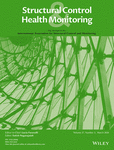Nonlinear model updating of a reinforced concrete pedestrian cable-stayed bridge
Summary
Strong earthquakes often cause different levels of damage to reinforced concrete (RC) bridges. The identification of their damage state and the prediction of their future seismic performance are thus necessary for hazard rescue and damage retrofit. To achieve this objective, the nonlinear model and the nonlinear model updating of the bridges are needed. This paper presents a fiber frame element-based nonlinear model and a new nonlinear model updating method for a RC pedestrian cable-stayed bridge. The fiber frame element-based nonlinear model is established in OpenSees, accounting for both material and geometric nonlinearities. The evolution principles of envelop curves, together with hysteretic rules with respect to reloading and unloading paths for both concrete and reinforcement materials, are considered. The new nonlinear model updating method is developed in the time domain, utilizing both global and local structural responses. The new updating method can evaluate not only time-dependent strength degradation but also time-dependent stiffness deterioration so that the current damage state of the bridge can be identified and the future seismic performance and damage state can be predicted. Finally, shake table tests were carried out on the 1:12 scaled RC pedestrian cable-stayed bridge, and the comparison of the predicted global and local seismic responses of the bridge with the measured ones confirms the accuracy and effectiveness of the proposed nonlinear modelling and model updating methods.




